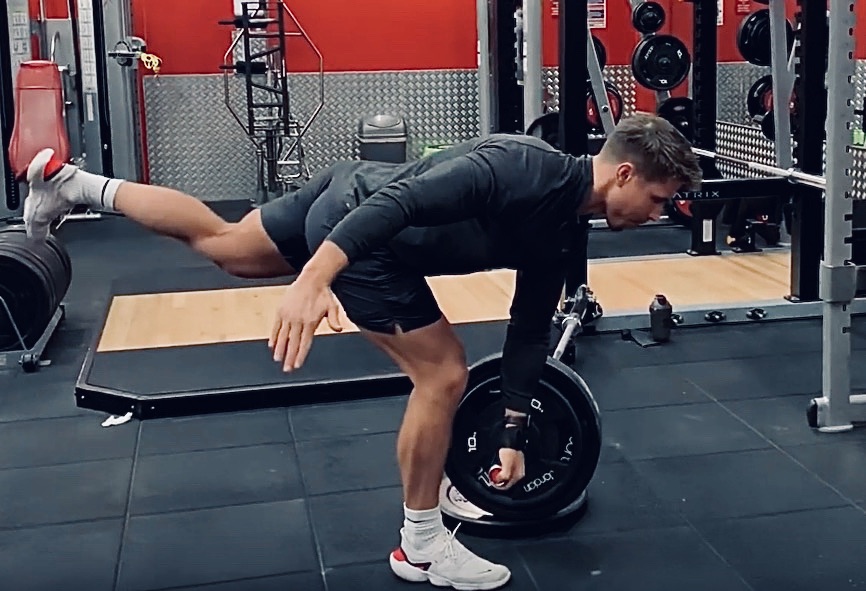The Deadstop Landmine Single-Leg Romanian Deadlift (RDL) may sound like a handful, but mastering this single-leg deadlift variation will allow you to build functional strength and size, without looking like an awkward balancing act. Here’s how it’s done.
Setup
You’ll need a landmine unit. Depending on your own range of motion, you’ll also want to adjust the height of the landmine off the floor accordingly. In the video you’ll see that I’m using olympic size plates, with another 1-inch plate on the floor. You can adjust your depth by either changing the size of the plates on the landmine, or the height it sits off the floor (plates or a step). You can also stand on a plate or box for a greater range of motion.
Coaching Tips
- Face side-on to the landmine unit and parallel to the bar. Your outside foot will be roughly level with the end of the barbell, although this can vary somewhat.
- Pick up the bar with your inside hand, opposite to the foot that’ll be planted (a contralateral grip).
- Start from the top and take your inside leg off the floor. Adjust your outside leg until you find a position of balance.
- Take your inside leg back, hinge your hips and tilt your torso forward.
- Keep your back knee a little bent while focusing on pushing your hips back for maximum hamstring engagement. The weight should move back through the heel of your planted foot.
- When you reach the floor pause for a brief second. DO NOT LOSE THE WEIGHT FULLY. Instead, consider just 50% of the weight of the bar to be lost on the floor, so as to maintain body tension.
- Pause for up to 1-2 seconds. You should really feel your hamstrings here. The longer you pause the harder it’ll be to overcome the inertia of the dead weight.
- Stand up and return your non-supporting foot to the floor to finish. Alternatively you can choose to keep it off the floor.
- As the end of the landmine can be hard to grip, especially when using the respectable weights you can achieve here, feel free to use lifting straps. Alternatively you can set the bar up using the hack below, which allows you to grip a landmine easier for deadlift or row variations.
Why these single-leg deadlifts work
The dead-stop – The stop forces you to overcome the inertia of the dead weight. It also partially inhibits stretch-reflex mechanisms within the muscle and connective tissues. This in turn forces more contractile components to lift the weight. Basically, you’re forcing your muscles to work harder.
It emphasizes your hamstrings and glutes in a stretched position – Placing a dead-stop in certain positions can be used to target different muscle lengths (e.g., stretched v.s shortened). This can be used to target differing muscle and strength building mechanisms. For example, with the landmine single leg RDL you’re working your hamstrings and glutes more in a lengthened position, where a lot of tissue breakdown can occur – a good thing for muscle hypertrophy, but a bad thing if you hate next day muscle-soreness!!
It’s a more stable single-leg deadlift – Single-leg deadlifts can be an excellent choice of exercise for developing functional strength and athleticism. Unfortunately though many struggle with the instability, which can often get in the way of sufficient muscle tension and weight on the bar. Because of the dead-stop and the support the landmine offers, these are a good choice of unilateral exercise for those looking to build strength and size, without limited by their instability.
It’s a contralateral exercise – Your working leg and gripping hand are on opposing sides of your body. Contralateral exercises mostly rely on using an interconnected line of tissues that link your glutes on one hip to the opposite side lats, essentially creating an X-shape that crosses your lower back. Developing stabilization through this “X” is essential for most athletes, as well as those looking to develop functional strength that can transfer over to daily activities.
Variations
- Change arms – You can use an ipsilateral grip with the weight in the same hand as your planted leg.
- Use a dumbbell or a kettlebell – less space required, and a more unstable progression.
- Use a barbell – an advanced and more unstable progression.
- Elevate your toes – a heel wedge under your toes of the planted foot will emphasise your hamstrings more, and you’ll feel the stretch sooner.
- Change the height of the dead-stop to work different portions of your deadlift. E.g., pull from just below your knee, mid-thigh etc.
- Add band resistance to accommodate for increased strength at the top of the lift. This can be attached to the landmine.
- Try a mechanical drop set – start with dead-stop reps then squeeze out a handful of tap-and-go reps to extend the set.
Not there yet?
That’s fine. Try these single-leg banded deadlifts as part of your warm-ups, or even between sets, to develop the same movement pattern. You can do this with your own bodyweight, but this setup with the band offers a little extra stability, as well as resistance.
Take-home
You can program this exercise using a variety of set and rep ranges, and according to your current goals. Use this single-leg deadlift as a tool to build single-leg strength and size without your lack of stability getting in the way.
Find out about the Maverick Glutes and Hamstrings Guide HERE.

I build Olympians, Cover Models and those who want to look like them. Author or “Ultimate Abs” available in all good book stores.
